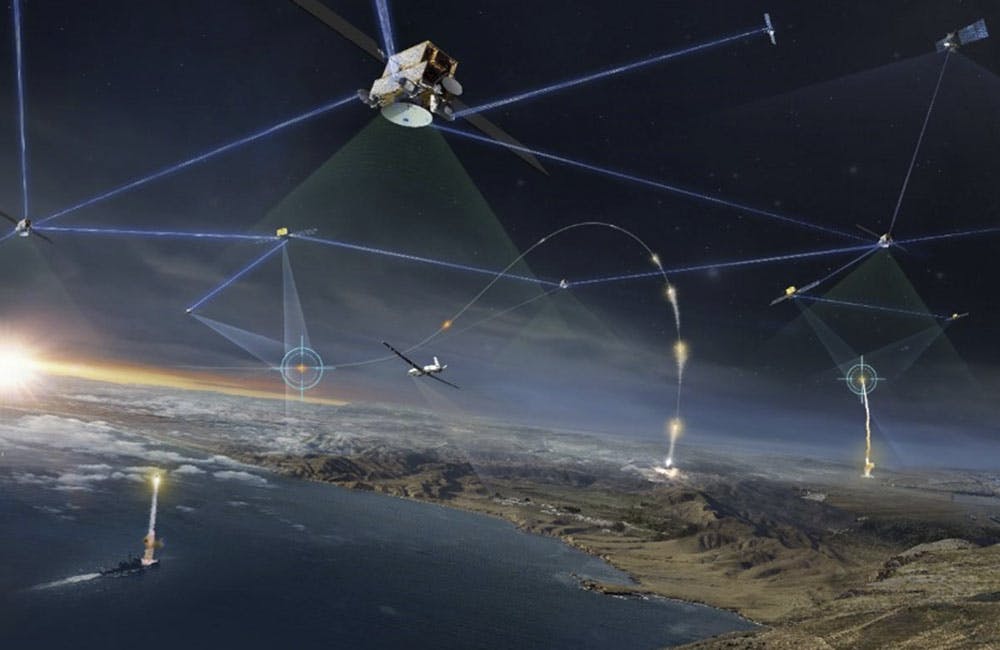Tactical Data Link Satellites Will Soon Begin Testing Over NATO Territory
The Link 16 network is the first step in developing a hybrid satellite communications terminal, according to defense officials.

NATIONAL HARBOR, Maryland — As the Defense Department builds its CJADC2 infrastructure across the department here on Earth, the agency is working toward building connectivity in space via satellites, leaders from the Space Development Agency (SDA) said at the Sea-Air-Space conference.
SDA Director David Tournear said Tuesday that the agency has continued to bring Link 16 satellite communications to Five Eyes partners and will soon test the out-of-this-world technology over NATO territory.
Link 16 tactical data links, which have been around since the 1970s, are considered a key part of DOD’s CJADC2 initiative. The communication layer, which recently was only able to be connected via terrestrial line of sight connections extending about 300 nautical miles, is the only common tactical data link between all branch services of the U.S. military as well as its key allies.
“I don’t want to get too far ahead of some different announcements, but we have been working very closely with NATO allies. We are going to actually put some ground entry points for Tranche 1 in their territory itself,” Tournear said. “We have been doing all of our Link 16 testing to date over Five Eyes partners territory, and we’re going to start shortly doing that testing over NATO allied partners who are willing to work with us to do that. They’re excited to be able to get the capability in their hands.”
Tournear said SDA currently has 27 satellites in orbit as part of a Tranche 0 demonstration capability, to let users experiment and “use the proliferating constellations in an actual exercise.”
As operators become more comfortable with the technology, SDA will launch Tranche 1 this year, with the goal of having it operational by the end of next year. Tranche 1 will expand Tranche 0’s 27 satellites to roughly 160 and deliver Link 16 capability over the entire globe. Twenty-eight satellites will be capable of missile warning and tracking missions and four will take on missile defense and fire control systems.
Tournear said the SDA is implementing the technology in a “spiral development approach” where capabilities are released within two-year timeframes until 2027 to bring the capabilities about in a “very timely, affordable and resilient manner.”
Tournear said that establishing Link 16 communication between satellites and ground stations on Earth is one step in the overarching vision of a hybrid satellite communication (SATCOM) terminal, capable of switching manually (and eventually autonomously) between Link 16 frequencies, other SATCOM frequencies like Ku and Ka, as well as commercial low-Earth orbit, medium-Earth orbit and geostationary-equatorial orbit frequencies in what he called a “diversity of orbits.”
When Tranche 2 is operational, Tournear said it can provide Link 16 capability through “full global persistence.”
“We can provide that service everywhere on the globe where you don’t have to make tradeoffs between areas. Then Tranche Three, you essentially get that whole global with resilience, because now you have enough satellites up there and diversity between all of the orbits to where not only you have that global persistence, but you have it in a very resilient manner,” Tournear said.
This is a carousel with manually rotating slides. Use Next and Previous buttons to navigate or jump to a slide with the slide dots
-

The Next AI Wave Requires Stronger Cyber Defenses, Data Management
IT officials warn of new vulnerabilities posed by AI as agencies continue to leverage the tech to boost operational efficiency.
5m read -

Federal CIOs Push for ROI-Focused Modernization to Advance Mission Goals
CIOs focus on return on investment, data governance and application modernization to drive mission outcomes as agencies adopt new tech tools.
4m read -

Agencies Push Data-Driven Acquisition Reforms to Boost Efficiency
New initiatives aim to increase visibility of agency spending, improve data quality and create avenues to deploy solutions across government.
5m read -

Data Transparency Essential to Government Reform, Rep. Sessions Says
Co-Chair of the Congressional DOGE Caucus Rep. Pete Sessions calls for data sharing and partnerships to reduce waste and improve efficiency.
5m read -

DOD Can No Longer Assume Superiority in Digital Warfare, Officials Warn
The DOD must make concerted efforts to address cyber vulnerabilities to maintain the tactical edge, military leaders said at HammerCon 2025.
4m read -

DHA CDAO Spearheads Master Data Catalog to Boost Transparency
Jesus Caban plans to boost DHA's data maturity through a new master data catalog, governance frameworks and inventory of tech tools.
5m read -

IRS Makes Direct File Code Public as Lawmakers Debate Program’s Fate
The agency sees the Direct File source code as beneficial to government digital services despite what happens with it in proposed budgets.
5m read -

A Look at Federal Zero Trust Transformation
Recent developments from CISA and DOD show how government is advancing zero trust quickly.
20m read -

New Army Acquisition Plan Cites Autonomy, Predictive Analytics
Officials outline how the Army Transformation Initiative signals a broader shift toward efficiency with tech and acquisition reform.
4m read -

DOE National Labs Launch New AI Tools for Operational Efficiency
The Energy Department's National Laboratories are using AI to increase operational efficiency and drive research efforts forward.
3m read -

Human-AI Collaboration is Key to Secure Government Systems
Former CIA security chief emphasizes training and international standards for effective AI implementation.
23m watch -

Air Force, Coast Guard Talk Data Security Efforts for AI Development
The services' AI initiatives include efforts like creating clean training data, countering data poisoning and bridging siloed teams.
4m read
















